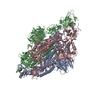+Search query
-Structure paper
| Title | S:D614G and S:H655Y are gateway mutations that act epistatically to promote SARS-CoV-2 variant fitness. |
|---|---|
| Journal, issue, pages | bioRxiv, Year 2023 |
| Publish date | Mar 31, 2023 |
 Authors Authors | Leonid Yurkovetskiy / Shawn Egri / Chaitanya Kurhade / Marco A Diaz-Salinas / Javier A Jaimes / Thomas Nyalile / Xuping Xie / Manish C Choudhary / Ann Dauphin / Jonathan Z Li / James B Munro / Pei-Yong Shi / Kuang Shen / Jeremy Luban /  |
| PubMed Abstract | SARS-CoV-2 variants bearing complex combinations of mutations that confer increased transmissibility, COVID-19 severity, and immune escape, were first detected after S:D614G had gone to fixation, and ...SARS-CoV-2 variants bearing complex combinations of mutations that confer increased transmissibility, COVID-19 severity, and immune escape, were first detected after S:D614G had gone to fixation, and likely originated during persistent infection of immunocompromised hosts. To test the hypothesis that S:D614G facilitated emergence of such variants, S:D614G was reverted to the ancestral sequence in the context of sequential Spike sequences from an immunocompromised individual, and within each of the major SARS-CoV-2 variants of concern. In all cases, infectivity of the S:D614G revertants was severely compromised. The infectivity of atypical SARS-CoV-2 lineages that propagated in the absence of S:D614G was found to be dependent upon either S:Q613H or S:H655Y. Notably, Gamma and Omicron variants possess both S:D614G and S:H655Y, each of which contributed to infectivity of these variants. Among sarbecoviruses, S:Q613H, S:D614G, and S:H655Y are only detected in SARS-CoV-2, which is also distinguished by a polybasic S1/S2 cleavage site. Genetic and biochemical experiments here showed that S:Q613H, S:D614G, and S:H655Y each stabilize Spike on virions, and that they are dispensable in the absence of S1/S2 cleavage, consistent with selection of these mutations by the S1/S2 cleavage site. CryoEM revealed that either S:D614G or S:H655Y shift the Spike receptor binding domain (RBD) towards the open conformation required for ACE2-binding and therefore on pathway for infection. Consistent with this, an smFRET reporter for RBD conformation showed that both S:D614G and S:H655Y spontaneously adopt the conformation that ACE2 induces in the parental Spike. Data from these orthogonal experiments demonstrate that S:D614G and S:H655Y are convergent adaptations to the polybasic S1/S2 cleavage site which stabilize S1 on the virion in the open RBD conformation and act epistatically to promote the fitness of variants bearing complex combinations of clinically significant mutations. |
 External links External links |  bioRxiv / bioRxiv /  PubMed:37034621 / PubMed:37034621 /  PubMed Central PubMed Central |
| Methods | EM (single particle) |
| Resolution | 4.1 Å |
| Structure data | EMDB-29910, PDB-8gb0: |
| Source |
|
 Keywords Keywords | VIRAL PROTEIN / SARS-CoV-2 / Spike Protein / Glycoprotein / Trimeric Complex |
 Movie
Movie Controller
Controller Structure viewers
Structure viewers About Yorodumi Papers
About Yorodumi Papers






